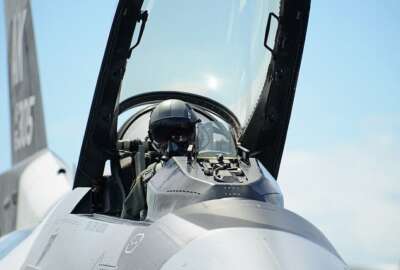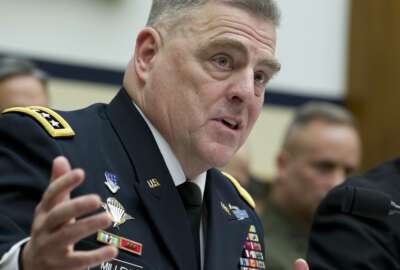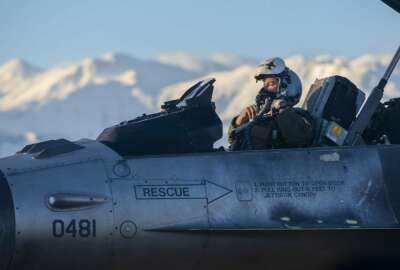
New Air Force secretary announces new pilot incentives, bashes budget unpredictability
In one of her first public appearances, Air Force Secretary Heather Wilson gives pilots more flexibility in contract lengths.
In one of her first public appearances, Air Force Secretary Heather Wilson announced new enlistment options for pilots and continued the military’s assault on budget unpredictability.
Wilson didn’t deviate much from Obama administration policies in her June 5 speech before the Air Force Association in Washington. Readiness, a slightly larger active force, focus on retaining top talent in the service and getting a solid, on-time budget from Congress all ranked high on Wilson’s priority list, just as they did with her predecessor Deborah Lee James.
But then again, the Trump administration has yet to actually formulate its national security strategy. The Defense Department is still undergoing a strategic review to inform future moves. That review is expected this summer.
Wilson announced the new contract commitment plan for Air Force pilots. It gives them the flexibility to sign commitment lengths of one, two, five or even 13 years of service depending on their specialty.
“Bomber, special ops and mobility pilots have a nine-year contract option while fighter pilots have nine-year and 24 years of aviation service (13-year maximum) options. RPA pilots, along with combat systems operators from various flying communities, are eligible for five-year contracts at varying amounts, tiered by critical needs,” a June 5 Air Force press release stated.
In addition to contract options, the Air Force is increasing the maximum reenlistment bonus pay from $25,000 to $35,000.
“We are prioritizing areas, particularly fighter pilots, where we are already in a crisis state so they have the opportunity for the highest bonus,” Wilson told reporters after the speech.
Though the service has greater flexibly on what it can offer pilots, it’s also focusing on non-monetary issues as well.
“It’s not just the money and pilots tell us this, it’s the additional duties, it’s the deployment rates and then it’s when you’re not deployed you’re still at a very high pace doing all kinds of training. Some of which doesn’t really add value. We are looking at all those non-mission oriented things to try to improve the quality of life,” Wilson said.
Flying hours are also a concern for Wilson.
“A lot of the flying hours when pilots are fully deployed right now are not high intensity kinds of missions, so they don’t feel ready for the near peer threat adversaries … I’ve never met a unit that’s focused and ready where the morale isn’t high,” Wilson said.
The 2018 budget adds to the pilot training capacity and provides personnel support to two new F-16 flying training units.
The Air Force has been working on retaining pilots and other key specialties since the Obama administration. The service is more than 1,500 pilots short of what it needs.
Former Air Force Secretary Deborah Lee James cut additional duties and training under her tenure.
Air Force Chief of Staff Gen. David Goldfein hosted a National Pilot Sourcing meeting last week with airline executives to ensure high quality pilots of the needs of the nation.
RAND, the University of North Dakota, the National Air Carrier Association, Airlines for America, Civil Air Patrol, the Regional Airline Association and the Air Force briefed participants.
“I need 1,200 [pilots] a year, [the airlines] need 4,500 a year, for 10 years. They exhaust my supply pretty quick and they exhaust our supply pretty quick, so the next place they are going to go is international,” Goldfein told Federal News Radio last month. “We really have to look at this holistically to say, ‘What are the nation’s needs for a pilot force to do commercial business, private and military aviation?’ and then ‘How do we look at new creative ways of plussing-up the supply.”
A May 19 press release from the Air Force stated the Air Force and airline executives decided to work together to provide more accessible pathways for students of aviation to reach their goal and to create new pathways to becoming a pilot.
“Today’s aviation enterprise doesn’t adequately meet the needs for national defense and national commerce,” said Goldfein. “This is the beginning of something I think will have big payoffs if we’re disciplined in the way we approach it.”
Predictability
None of the Air Force’s goals can happen without a budget in 2018 and there are some significant hurdles to that.
Wilson stressed the military needs budget predictability to succeed.
The 2018 budget request increases the Air Force’s active duty levels to 325,000. It also invests in cyber, tankers, fighters and bombers.
Wilson said the Air Force is also trying to invest more into the research and development side of the service.
None of that can happen without Congress passing a 2018 budget. It was about six months late in doing that for 2017.
This budget has an extra hurdle considering sequestration is set to return. Congress must figure out a way to increase the budget caps and pass a budget if it wants to fund to DoD’s requested levels.
The military service chiefs said earlier this year that repeated continuing resolutions and unpredictability were taking a toll on the military’s readiness.
“It’s the cumulative effect. We’ve been doing CRs now for eight years and a shutdown in [20]13,” Army Chief of Staff Gen. Mark Milley said during a House Armed Services Committee hearing. “It’s like smoking cigarettes. One cigarette is not going to kill you, but you do that for eight, 10, 20 years, 30 years you’re eventually going to die of lung cancer.”
Copyright © 2024 Federal News Network. All rights reserved. This website is not intended for users located within the European Economic Area.
Scott Maucione is a defense reporter for Federal News Network and reports on human capital, workforce and the Defense Department at-large.
Follow @smaucioneWFED





